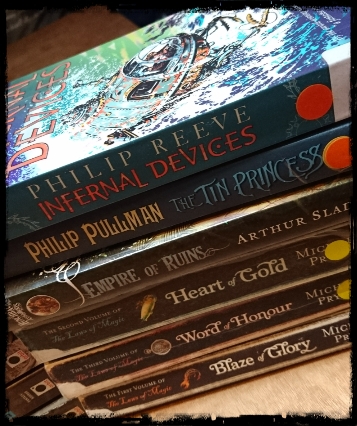Recently I’ve participated in some interesting conversations about the classification of steampunk, as a writing genre. Many writing/steampunk blogs consider it be part of the fantasy branch of speculative fiction. Friends seem divided. Book shops (and Amazon) often place steampunk books in the science fiction shelves. So let’s have a closer look and you can decide.
First, let’s discuss some definitions. What is science fiction and what is fantasy? I could easily allocate an entire blog post just on the definitions but I won’t.
Isaac Asimov said it best:
“Science fiction, given its grounding in science, is possible; fantasy, which has no grounding in reality, is not.”
So, science fiction deals with things that might possibly happen, or have happened. Fantasy deals with things that will never happen, have happened or ever will happen, the impossible. Easy, right?
Well, lets define steampunk (not an easy task in itself).
Steampunk is the name given to a genre of fantasy or alternative historical stories – usually set in the 19th century or an alternative future reminiscent of the 19th century – with the science fiction element containing modern technology powered by steam. The amount of steam and gadgetry is variable. Sometimes supernatural themes may be incorporated. Think of it as retro-futurism with a Victorian science fiction twist. (from my steampunk page)
Hmm? I’m hedging my bets and used both fantasy and science fiction in my definition.
Let’s try again, with a few more defintions:
- Google defines it as “a genre of science fiction that has a historical setting and typically features steam-powered machinery rather than advanced technology.”
- The Urban Dictionary defines it as: “Steampunk is a subgenre of speculative fiction, usually set in an anachronistic Victorian or quasi-Victorian alternate history setting. It could be described by the slogan “What the past would look like if the future had happened sooner.” It includes fiction with science fiction, fantasy or horror themes.”
- And the Steampunk Bible defines it as “a grafting of Victorian aesthetic and punk rock attitude onto various forms of science-fiction culture.”
It even gives us a formula: Steampunk = Mad Scientist Inventor [invention (steam x airship or metal man/baroque stylings) x (pseudo) Victorian setting] + progressive or reactionary politics x adventure plot.
Maybe the origins of steampunk hold a clue?
KW Jeter first coined the name, ‘steampunk’, in 1987 (not 1887). Some consider works by HG Wells or Jules Verne as steampunk but these were science fiction (or ‘science romances’ written in the 19th century). The writers extrapolated possible futures (there’s that word again), based on plausible advances in science – as they knew it (or thought they did) ie. the science of their time. But we now know things like phlogiston do not exist. Modern speculative stories using such forms of energy would now be consider fantasy (impossible) and not science fiction. Steampunk, having been born in my generation, is a completely different animal.
Confused yet? Let’s investigate further: Steampunk = steam + punk.
Traditional steampunk’s aesthetic is dripping with technology. You can find airships, steam-machines, automatons (robots) and gadgets galore – usually steam-driven; all things plausible within Victorian beliefs of the time. While usually set in the past, it can embrace apocalyptic futures. Travel in space and time are common tropes. Sounds like science fiction, eh?
The Difference Engine, by William Gibson and Bruce Sterling, tells of an alternative history revolving around the consequences of Charles Babbage’s analytical engine (A working difference machine based on Babbage’s engine has been built.)
Then there’s the punk part: Social commentary, contemplating technologies effect on people (albeit steam), the role of women, the battle of the classes, racism, slavery or colonialism, can all be found in many steampunk stories. All are reminiscent of the long tradition of social commentary found in science fiction.
But…
Then some steampunk stories incorporate mythical or supernatural creatures and magic. Gail Carriger’s Soulless has vampires and werewolves. Boneshaker (Cherie Priest) has zombies. Other stories incorporate magical machines or fantastical energy sources. Airships sail through the vacuum of space. Improbable you say? Yes (but fun). So is steampunk fantasy after all?
In a true spirit of fun and thumbing its nose at the literary establishment, steampunk blurs the line between science fiction and fantasy, providing an entertaining alternative for readers. It’s a hybrid genre still in its adolescence, with too much punk to be defined only as fantasy and too many fantastical elements to be considered solely science fiction. Perhaps that’s why I love it?
So, science fiction or fantasy? What do you think?


Sorry, Karen, I’ve seen nothing here to move me from my old position: Steampunk is not a genre, it is a background against which genre stories can be told. From sweet romance to brutal tales of murder and vengeance, seances to balloon-bound explorers opening new continents, it’s both, and in some odd ways, neither. Modern romance, regency romance, steampunk romance, all that changes are the settings. A man kills his brother over their inheritance, then goes on the lam. Does he ride a horse, drive a car, or sail off in a fantastic submarine? It’s the same story, it’s merely set in one world or another. It’s the canvas. Fans and critics admire the painting; no one, as far as I know, scrapes off a corner to see what brand of canvas the artist painted on.
So, how is life treating you, my old friend? Well, I hope!
A fair comment. I’ve heard people say the same of science fiction and fantasy as well. But still I hear (and read) the debate on where it should be put in the library or bookshops. Mine ended up in Murder Mystery at the local library.
Personally, I consider it a life-style and a mind-set, straddling both science fiction and fantasy. Perhaps it should be considered a separate genre unto itself?
(Life’s been interesting of late. Slowly improving. Got over the non-writing hurdle now my health is improving. Thanks for asking, Jack.)